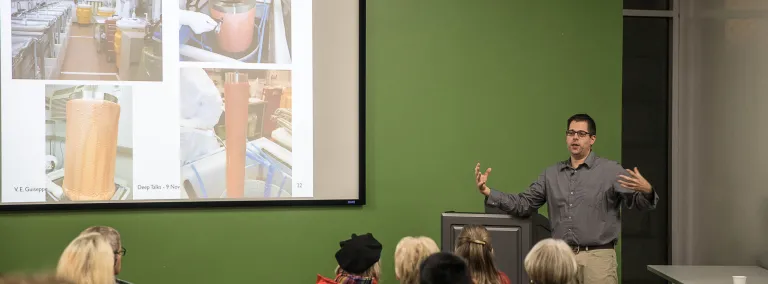MAJORANA collaboration releases results
"As humans, we want to know what things are, how they came to be and why we exist."
In 1937, Italian physicist Ettore Majorana hypothesized the existence of the Majorana fermion, a particle that is its own anti-particle. His hypothesis informed the basis for decades of neutrino-based experiments, including the Majorana Demonstrator Project, which is looking for a rare form of decay called neutrinoless double-beta decay.
“If the neutrino is its own antiparticle, it could explain a lot about our universe,” said Vincente Guiseppe, co-spokesperson for the Majorana collaboration and an assistant professor of physics and astronomy at the University of South Carolina. “Such a discovery could help explain why there is more matter than anti-matter in the universe—and why we exist at all.”
After years of planning, building the experiment and collecting data, the collaboration has something to celebrate. At last week’s Deep Talks, Guiseppe announced the initial physics results. And although neutrinoless double-beta decay was not observed, the Majorana collaboration still has much to celebrate, Guiseppe said.
“We know that we created an environment that is incredibly clean and quiet. These initial results give us a better understanding of the always-elusive neutrino and how it shaped the universe.”
The collaboration went to great lengths to create such a quiet environment. For the past six years, the team grew the world’s purest copper to build the demonstrator. Two ultra-pure copper cryostats each hold approximately 22 kg of enriched and natural germanium. And both are housed inside a six-layered shield deep underground at Sanford Lab to escape cosmic radiation and other impurities that could create noisy events.
To observe this type of rare physics event in just two atoms, you’d have to wait over 2 x 1025 years. That’s a 2 followed by 25 zeroes.
“You might say that’s improbable—the universe is only 13.8 billion years old,” Guiseppe said in his presentation. “But so is the lottery. To increase your chances, you buy more lottery tickets.” In the case of Majorana, they had to increase the number of germanium atoms.
Still, they didn’t expect to see neutrinoless double-beta decay. The project is, first and foremost, a demonstrator, a research and development project built on a moderate scale to determine whether a larger version is feasible. And for it to be feasible, “We had to show that backgrounds can be low enough to justify building a next-generation experiment,” Guiseppe said.
Ettore Majorana disappeared mysteriously in 1938 while traveling by ship from Palermo to Naples, Italy. For decades rumors abounded about his disappearance: he committed suicide, he fell overboard and drowned or took refuge in a convent. An article from the 1950s suggests he resurfaced in Venezuela, South America, under an assumed name.
The Majorana collaboration, however, has no intention of disappearing.
“We plan to continue operating the Demonstrator to study its performance, better estimate the backgrounds we observe and test some hardware upgrades,” Guiseppe said. “In a few years, we’ll hit a point of diminishing returns. At that time, we can make better use of the detectors along a path towards a next-generation experiment.”
That next generation is LEGEND, the Large Enriched Germanium Experiment for Neutrinoless ββ Decay, which will contain up to 1,000 kg of germanium. Last year, the collaboration joined forces with members of GERDA (GERmanium Detector Array), as well as other researchers in this field to begin planning for LEGEND. GERDA, another neutrinoless double-beta decay experiment, used commercial copper and shielded its detector inside a tank of liquid argon, which scintillates, or lights up, when backgrounds enter.
How can they be sure the next generation will work? They can’t. Still, they are compelled to keep searching.
“We live in a curious world. And as humans, we want to know what things are, how they came to be and why we exist,” Guiseppe said. “That’s why our collaboration is studying neutrinos. That’s why so many other experiments around the world study neutrinos.”
